Once more, the city of Sandy Springs has tinkered with its false alarm ordinance.
At its meeting on Tuesday, the City Council approved changes to the ordinance, which will require alarm companies to provide “true, confirmed verification” of an emergency through audio, video or in-person communication on alarms prior to the company calling 911.
In simpler terms, if the alarm company is contacting the Sandy Springs Police Department, it needs to have some sort of evidence of a real emergency.
This amendment to the ordinance will go into effect on June 19, 2019, giving companies a year to comply and to implement the new process.
READ | Grammy-winning singer to perform this summer in Sandy Springs
READ | Culver's is now open in North Fulton
READ | Doctor who lived to be 114 has street named after her in Sandy Springs
The proposed change to the ordinance was presented to the City Council by Sandy Springs Police Chief Ken DeSimone. He referenced recent statistics showing that his police force is still responding many false alarm calls. For the week ending on June 2, police received 143 calls to 911 from alarm companies and all of those were false, according to DeSimone's statistics.
“The problem is alarm companies are reporting equipment malfunctions as emergencies. They are not properly vetting to see if there is a true emergency occurring which has placed an ongoing strain on public safety resources,” DeSimone said. “Technology today makes it possible to have audio or visual verification, even for the homeowner to do on his own. By implementing true verification, we will reduce the number of these false calls, enabling a faster response for those calls which are true emergencies.”
The “true verification” system has already been implanted in several cities across the country, such as Detroit, Michigan; Seattle, Washington; Las Vegas, Nevada; San Jose, California and Salt Lake City, Utah.
A team from Sandy Springs visited Salt Lake City last month and discussed the system with public safety personnel. Salt Lake City began the true-verification system in 2000, a year where police there responded to 9,439 alarm calls. In 2017, police in Salt Lake City responded to just 325 alarm calls.
READ | 2026 World Cup: 4 reasons why North American bid matters for Atlanta
READ | Sandy Springs is 5th best for young families to buy a home, study says
READ | Johns Creek works with Google to provide images of parks, rivers
As part of the ordinance amendment, the city is also requiring alarm companies to copy them on notifications to users regarding assignments of permit numbers and notifications of when service is suspended because the company failed to comply with the ordinance. Those changes will be implemented immediately.
Sandy Springs created its false alarm ordinance in 2013, but changed it recently in an effort to stop police from wasting time by responding to false alarms. In July 2017, the City Council approved an amendment that put the responsibility of registering the alarm on the company, not the homeowner. The City Council also began fining companies for false alarms.
Many of those fines went unpaid, and in April the city revoked the registration of 39 alarm companies. Many have paid the fines since. In May, the city approved changes to reduce those fines and extend the appeal window.
“The current system of fining in hopes of a behavior change is not working,” DeSimone said. “To bring about true change, we need to address the problem from a more holistic approach. The root cause of the issue is verification of an alarm activation.”
Like North Fulton County News Now on Facebook | Follow on Twitter
MORE...






